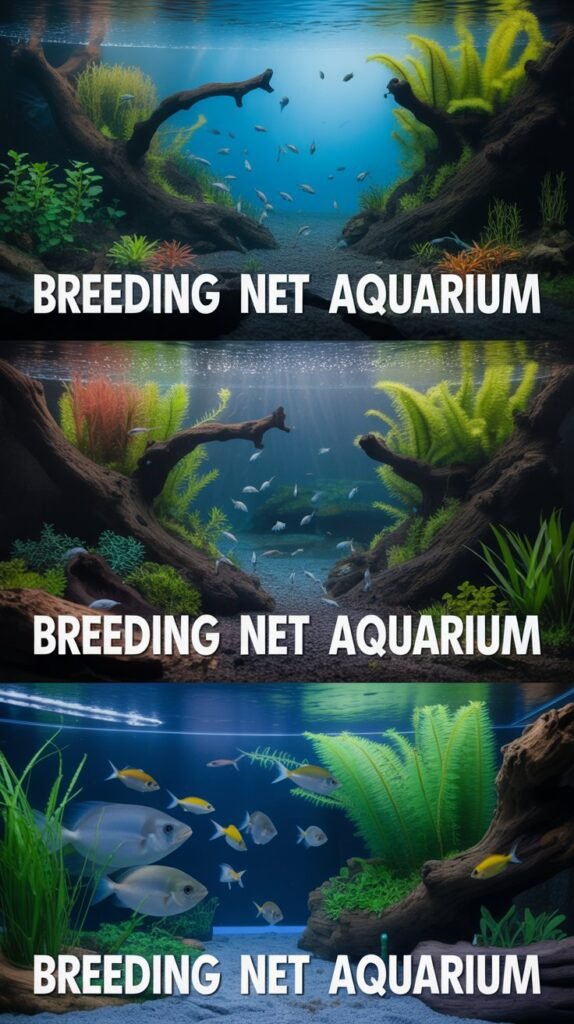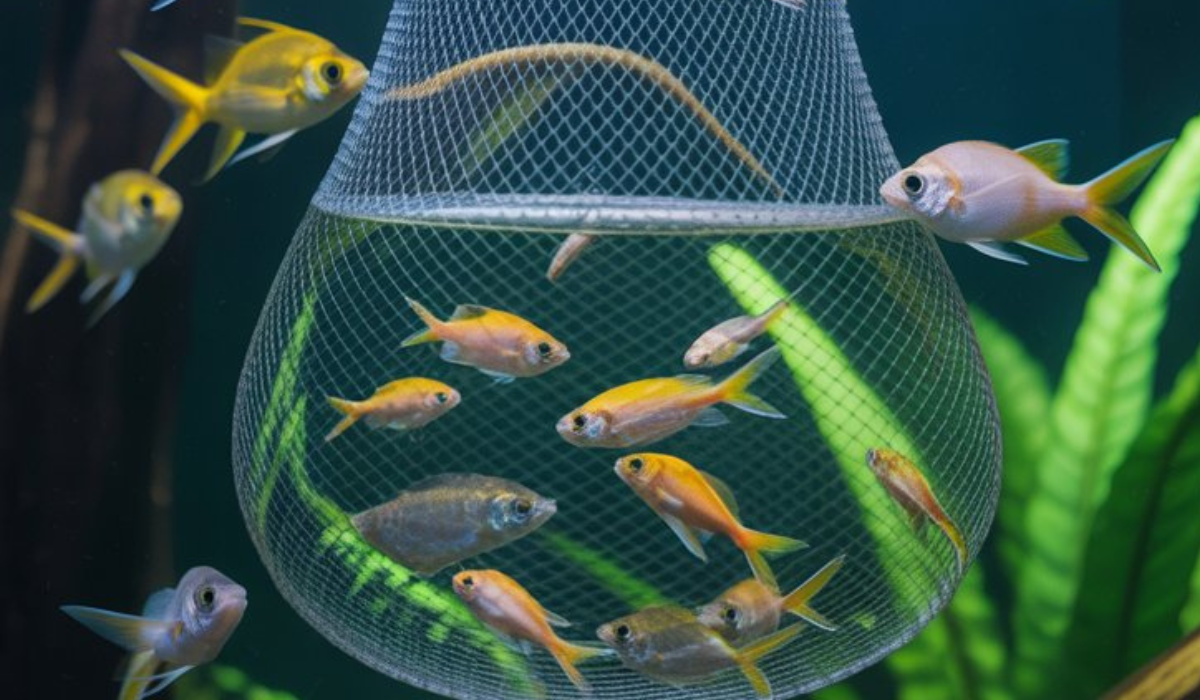Keeping fish is more than just maintaining an aquarium — it’s about creating a thriving ecosystem where aquatic life can grow, breed, and flourish. When it comes to breeding fish, especially livebearers like guppies, mollies, and platies, a breeding net aquarium plays an essential role in ensuring the safety of newborn fry (baby fish). This comprehensive guide will explain everything you need to know about using breeding nets, their benefits, setup, and maintenance, along with expert tips to help you achieve successful breeding results.
What Is a Breeding Net Aquarium?
A breeding net aquarium (also called a fish breeding box or fry isolation net) is a small enclosure made of fine mesh or plastic that’s placed inside the main aquarium. It’s designed to keep fry safe from adult fish that might eat them and to provide an ideal environment for them to grow until they are big enough to survive in the main tank.
These nets are especially popular among aquarists who breed livebearers like guppies, swordtails, and mollies, or egg-laying fish that may show predatory behavior toward their offspring.
Why You Need a Breeding Net in Your Aquarium

Many aquarists overlook the importance of a breeding net, thinking that a large tank or enough hiding spaces are sufficient for fry survival. However, in most community tanks, fry survival rates are extremely low without proper protection.
Here are the main reasons why using a breeding net aquarium is essential:
1. Protects Fry from Predators
Adult fish often see newly born fry as food. A breeding net isolates the babies, preventing them from being eaten.
2. Provides a Controlled Environment
The net ensures a stable environment where the temperature, oxygen, and water quality remain consistent with the main tank, reducing stress for the fry.
3. Ideal for Pregnant Females
Pregnant female fish can be placed in the net before giving birth. Once the fry are born, the mother can be removed, minimizing the risk of predation.
4. Helps in Fry Growth
The enclosed space makes it easier to monitor feeding and growth progress, ensuring that every fry gets enough nutrition.
5. Reduces Stress for Fry
Without aggressive or curious tankmates, fry experience less stress, which leads to faster growth and better survival.
Types of Breeding Nets for Aquariums
There are several types of breeding nets available in the market, each designed for specific needs. Let’s look at the most common ones:
1. Mesh Breeding Net
This is the most popular type made from fine nylon mesh stretched around a plastic frame. It allows free water flow and provides excellent oxygenation.
Pros:
- Easy to install
- Allows natural water circulation
- Affordable and widely available
Cons:
- May tear over time
- Requires cleaning to prevent algae buildup
2. Plastic Breeding Box
A transparent plastic box that attaches to the aquarium using suction cups or hooks. It often comes with a divider that separates the mother from the fry.
Pros:
- Durable and long-lasting
- Easier to clean than mesh nets
- Provides clear visibility of fry
Cons:
- Slightly restricts water flow
- Needs manual water exchange if not connected to tank filter
3. Floating Breeding Net
This type floats at the top of the aquarium using foam or air-filled edges. It’s ideal for small fry that stay near the water surface.
Pros:
- Great oxygen exposure
- Easy to access for feeding
Cons:
- Can move around if not secured properly
4. Divider Breeding Section
Some aquarists use tank dividers to section off part of the aquarium for breeding. This is a more natural option but takes more space.
Pros:
- Larger area for fry
- Natural water conditions
Cons:
- More difficult to manage and clean
How to Set Up a Breeding Net Aquarium

Setting up a breeding net is simple, but doing it correctly makes all the difference in fry survival. Follow these steps for best results:
Step 1: Choose the Right Size
Pick a breeding net that fits well within your aquarium and allows enough room for the mother fish and her fry to move comfortably.
Step 2: Attach It Securely
Use the provided suction cups or hooks to attach the breeding net to the side or top of your aquarium. Make sure it’s stable and fully submerged.
Step 3: Prepare the Environment
Ensure your main aquarium’s water parameters are stable. The breeding net will share the same water, so check for:
- Temperature: 24–28°C (75–82°F)
- pH level: 6.8–7.8 (depending on species)
- Ammonia and nitrite: 0 ppm
- Gentle water flow
Step 4: Add Hiding Spots (Optional)
If your breeding net is large enough, you can add small plants like Java moss, Anubias, or Hornwort to make the fry feel safe and provide micro food sources.
Step 5: Introduce the Female
Move the pregnant female fish into the breeding net when you notice signs of near birth — a dark gravid spot, swollen belly, or isolation behavior.
Step 6: Remove the Mother
Once she gives birth, gently remove her from the breeding net. Leaving her inside for too long increases the risk of her eating the fry.
Caring for Fry Inside the Breeding Net
Fry are delicate and require proper care during their first few weeks. Here’s how to ensure they grow strong and healthy:
1. Feed Small, Frequent Meals
Fry need tiny food particles several times a day. Offer:
- Crushed flakes or pellets
- Baby brine shrimp
- Microworms
- Commercial fry food
Feed 3–4 times daily, ensuring no food remains uneaten.
2. Maintain Water Quality
Since breeding nets are smaller sections within the main tank, waste can accumulate quickly. Perform partial water changes in the main tank and gently clean the net to avoid clogging.
3. Provide Light and Shelter
Keep your tank well-lit to encourage algae growth, which serves as a natural food source. Also, ensure plants or decorations provide shelter.
4. Monitor Growth
Once the fry grow large enough (usually 3–4 weeks), transfer them to a grow-out tank or the main aquarium if they’re too big to be eaten.
Common Mistakes When Using a Breeding Net

Even experienced aquarists sometimes make errors when using breeding nets. Avoid these common mistakes:
❌ Keeping the Mother Too Long
Leaving the mother fish inside the breeding net for days can stress her out and lead to premature birth or fry predation.
❌ Poor Water Circulation
If water doesn’t flow well through the net, oxygen levels can drop. Position the net near the filter output for better circulation.
❌ Overcrowding
Too many fry in a small space can lead to competition for food and oxygen. If you have many fry, use multiple nets or move them to a grow-out tank.
❌ Skipping Cleaning
Algae and waste buildup can harm fry health. Clean the net regularly to maintain hygiene.
Tips for Successful Breeding with a Net
Here are a few expert tips to maximize your breeding success:
- Choose Healthy Parents: Always breed strong, disease-free fish with bright colors and active behavior.
- Isolate Early: Move the pregnant female to the net before birth, not after.
- Use Floating Plants: Plants like duckweed and Java moss provide comfort and safety.
- Keep Stable Parameters: Sudden temperature or pH changes can harm both mother and fry.
- Feed High-Quality Fry Food: Protein-rich diets help fry grow faster and develop vibrant colors.
- Avoid Excess Light: Too much light can stress fry. Use moderate lighting conditions.
- Observe Behavior: Watch for aggression or stress signs in the mother; remove her if needed.
Advantages of Using a Breeding Net Aquarium
- Protects delicate fry from predators
- Easy to install and affordable
- Allows mother fish to give birth safely
- Maintains consistent water parameters
- Enables close observation of fry development
- Ideal for beginners and experienced aquarists alike
Disadvantages of Breeding Nets
While breeding nets are highly beneficial, they do have a few limitations:
- Limited space may restrict movement
- Water circulation can be weaker if not placed properly
- Requires frequent cleaning
- Not suitable for large species or aggressive fish
Alternative Methods for Fry Protection
If you prefer not to use breeding nets, here are a few other options:
- Separate Breeding Tank: A dedicated small aquarium for breeding and raising fry.
- Dense Plantation: Heavily planted tanks with floating plants provide natural hiding places.
- Spawning Mops: Used for egg-laying fish to protect eggs from being eaten.
While these methods work, breeding nets remain the simplest and most efficient for beginners.
How Long Should Fry Stay in a Breeding Net?
The duration depends on the species and growth rate. Generally, fry should remain in the breeding net until they are large enough not to fit in an adult fish’s mouth — typically 2–4 weeks for most livebearers like guppies and mollies. Observe their size and activity before transferring them.
Maintenance Tips for Breeding Nets
- Rinse the net weekly in aquarium water (never tap water).
- Remove algae or debris gently with a soft brush.
- Check for tears or damage regularly.
- Reposition it if water flow becomes weak.
- Avoid using chemicals or soaps during cleaning.
Best Fish Species for Breeding Nets
Breeding nets are perfect for small and peaceful species, including:
- Guppies
- Mollies
- Platies
- Swordtails
- Endler’s Livebearers
- Betta fry (for isolation, not breeding)
- Tetras and Danios (for temporary fry protection)
Conclusion
A breeding net aquarium is one of the most practical tools for any aquarist interested in fish breeding. It provides a secure environment for fry to grow safely, reduces losses, and ensures the health of your aquatic family. Whether you are breeding guppies or other livebearers, using a breeding net can significantly increase your success rate.
By following the setup and care instructions outlined in this guide — maintaining clean water, feeding properly, and monitoring growth — you can enjoy the rewarding experience of raising healthy baby fish in your own aquarium.
FAQs About Breeding Net Aquarium
1. How long can fish fry stay in a breeding net?
Fry can stay in the breeding net for 2 to 4 weeks or until they are large enough not to be eaten by adult fish.
2. Can I keep the mother fish in the breeding net after giving birth?
No, it’s best to remove the mother immediately after birth to prevent her from eating the fry.
3. How do I clean a breeding net?
Rinse it in aquarium water (not tap water) and gently brush off any debris or algae buildup.
4. Can breeding nets affect water flow or oxygen levels?
Yes, if not placed near the filter outlet, water circulation may be limited. Position the net where water flow is moderate.
5. Are breeding nets suitable for all fish?
Breeding nets are best for small livebearers like guppies, platies, and mollies. Larger or aggressive species may not be suitable.
6. Can fry grow normally in a breeding net?
Yes, fry can grow healthily if fed well and provided with clean water and enough space.
7. Should I use an air stone inside the breeding net?
It’s not necessary, but adding one nearby can help improve oxygen flow.
8. Can I use plants inside a breeding net?
Yes, adding small plants like Java moss or Anubias helps fry feel secure and promotes natural feeding.
9. How many fry can a breeding net hold?
It depends on the size, but typically 15–30 fry for small nets. Avoid overcrowding for better growth.
10. Is a breeding net necessary for fish breeding?
It’s not mandatory, but it greatly increases fry survival rates, making it highly recommended for beginners.

